Imagine walking down the street in your city neighborhood and stopping by a garden, planted in what used to be a vacant lot, to buy some vegetables or fruit for supper. For many people, this is not pie-in-the sky dreaming. It’s a welcome reality — and a pleasant change in scenery.
As urban agriculture continues to put down roots in cities across the United States, more and more people are beginning to see its many benefits. The hope for the future is that it can flourish and sustain a new crop of farmers and farm businesses and help supply city dwellers with healthy food that’s been grown close by.
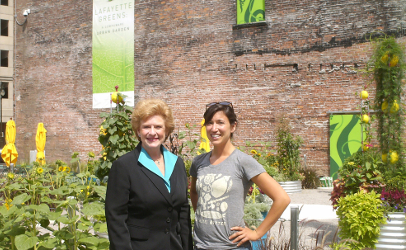
Helping to fuel that hope, U.S. Sen. Debbie Stabenow on Sept. 28, announced the most comprehensive urban agriculture bill to be introduced in Congress. A Democrat from Michigan, Stabenow is ranking member of the Senate Committee on Agriculture, Nutrition and Forestry.
The Urban Agriculture Act of 2016 would offer urban farmers new resources through the U.S. Department of Agriculture, according to Stabenow’s Senate office website. It would create a new urban agriculture office at USDA to coordinate policies across the department and provide urban farmers with technical assistance.
Pointing out that urban agriculture is steadily growing in the United States, the senator said the act will build on this momentum by helping urban farmers get started or expand their business “so they can sell more products and supply more healthy food for their neighbors.”
The bill would boost farming cooperatives, encourage rooftop and vertical farms, invest $10 million in research exploring market opportunities, and develop technologies for lowering energy and water needs.
It would also offer loans to finance food production and marketing; risk-management tools to protect crops, food prices, and contracts; and a mentorship support program.
Stabenow announced her legislation during a press conference at D-Town Farm in Detroit with Mayor Mike Duggan and Michigan urban ag leaders.
Currently at seven acres, D-Town Farm is the largest farm in Detroit. Located in a large city park, it is lined by a see-through deer fence and includes large hoop houses and open beds of tomatoes, garlic, beans and other vegetables. Its produce is sold at farm stands and farmers markets.
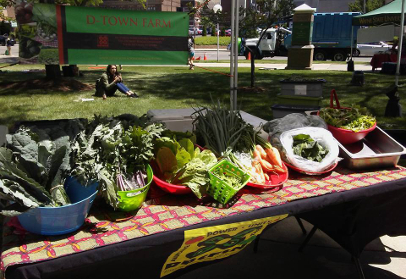
Launched in 2006 on just one-quarter of an acre, D-Town Farm is an “urban agriculture initiative” of the Detroit Black Community Food Security Network, which is dedicated to building food security and advocating for food justice for Detroit’s majority African-American community. Blacks or African Americans make up 82.7 percent of the city’s population.
Mayor Mike Duggan said here’s an abundance of available land in Detroit and groups like D-Town farms are putting it to productive use in a way that promotes good health and economic opportunity.
As for the abundance of available land in Detroit, there are an estimated 150,000 abandoned lots within in the city’s 360 acres.
“I hope that Sen. Stabenow’s bill will help efforts like this expand and allow others to follow in their footsteps,” Duggan said.
Long-time urban-ag leader Malik Yakini, executive director of the Detroit Black Community Food Security Network, also gives a thumbs-up to Stabenow’s legislation.
“As we rethink how we provide food in an environmentally sustainable way for an increasingly urban population, urban agriculture is an important component,” he said.
When it comes to the economic benefits of this approach, Yakini said “urban agriculture, and the associated businesses needed to support it, helps local economies to thrive.”
He also praised urban agriculture for its ability to grow food closer to population centers, which not only provides people with fresher, more nutrient-rich foods but also reduces the carbon footprint caused by transporting food long distances.
Joan Nelson, executive director of Allen Neighborhood Center, which operates the Allen Market Place in Lansing, MI, had some good news to share about urban ag.
“A steady increase in the number of urban farms in the Capital City is beginning to impact health and nutrition awareness, good food access, and food security, even as it is transforming fragile neighborhoods,” she said.
In praise of Stabenow’s urban ag act, Nelson said it will offer new resources, support, financial tools, educational and economic opportunities that will “most certainly accelerate and strengthen these promising changes in urban communities throughout Michigan.”
A member of the financial community, Dave Armstrong, president and CEO of GreenStone Farm Credit Services, also had good things to say about the legislation, pointing out that it’s an important step in “supporting the evolving agriculture industry.
He pointed to parts of the bill that focus on risk management, education and expanded loan guarantees.
In a conference call with reporters, Stabenow has conceded that the bill likely won’t pass in its current form. But she said it will start the conversation and build broader support for including urban farming as part of the next farm bill.
Starting the conversation
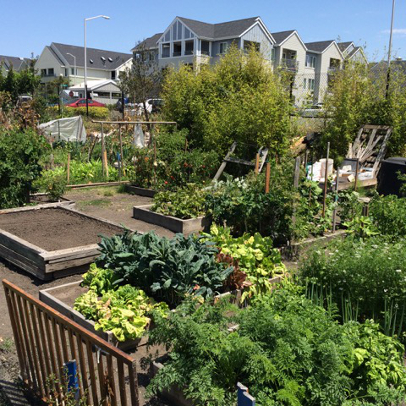
“It’s really exciting to see this — working toward getting the federal government to making a commitment to urban agriculture,” Jennifer Sowerwine, University of California cooperative extension food systems specialist, said.
“There are so many benefits across the spectrum — health, education, economics, food safety, and community health, among them.”
She also said it presents “tremendous opportunities” for low-income people in cities because urban farms help them learn about nutrition and how to cook fresh produce.
The National Farmers Union (NFU) is also pleased with the bill, saying it would expand USDA programs to support urban farmers, encouraging food production, job creation, urban revitalization and diversity in agriculture production
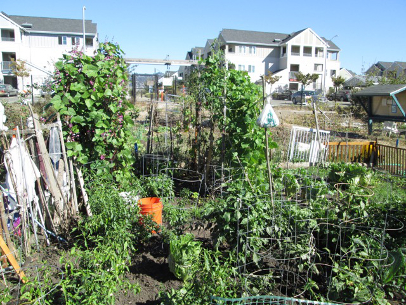
“Urban agriculture provides a feasible and sustainable business option for those wanting to get into farming, attracting new faces to the industry that may not have otherwise considered this profession,” said NFU President Roger Johnson. “This bill will help support the programs that are making these opportunities possible.”
City and suburban agriculture can be found in the form of backyard gardens, roof-top and balcony gardening, community gardening in vacant lots and parks, roadside urban fringe agriculture and livestock grazing in open space, according to the USDA.
The USDA does not keep track of the number of urban farms in the United States. But according to the Food and Agriculture Organization of the United Nations, 800 million people worldwide grow vegetables or fruits or raise animals in cities.
“Agriculture — including horticulture, livestock, fisheries, forestry, and fodder and milk production — is increasingly spreading to towns and cities,” according to the FAO website. “Urban agriculture provides fresh food, generates employment, recycles urban wastes, creates greenbelts, and strengthens cities’ resilience to climate change.”
What about food safety
The good news is that food safety is included in Stabenow’s bill in a variety of ways.
Stabenow’s spokeswoman Miranda Margowsky cited several sections in the bill that pertain to food safety:
Sec. 101 Increases funding for Extension activities, which can provide food safety technical assistance and good handling practice information.
Sec. 201 Under the business program review, the bill requires that USDA review/evaluate its technical assistance/training for good agriculture practices (GAPs) and food safety record keeping and must develop best practices to reach urban farmers.
Sec. 301 Addresses soil remediation.
Sec. 401 Includes funding for research on food safety issues related to urban agriculture production.
Nothing in the bill would restrict the community garden grant program from funding cooling equipment as part of overall projects.
First, the soil
When it comes to food safety and urban farming, it’s not as simple as pulling out a shovel and planting some seeds in an abandoned lot.
Land use in urban areas often leaves an unfortunate legacy of contaminated soil. Sites of former commercial or industrial buildings are frequently contaminated with asbestos, petroleum products, lead-based paint chips, dust and debris.
In the case of old houses, lead is often concentrated near their foundations. Even an old apple tree can raise suspicions because it could have been sprayed with an arsenic-based pesticide.
Along roadways, vehicle exhausts leave behind lead and PAHs (polycyclic aromatic hydrocarbons). Consequently urban farmers are advised to erect some sort of barrier between busy roadways and their growing areas, if possible.
Soil in former parks and along railroad rights-of-way can harbor pesticide residues.
Regardless of the former use, soil must be tested and remediated, if necessary, to get rid of as many contaminants as possible. But because testing for an array of toxins can be expensive, and because remediating the soil can be a huge challenge and further expense, some urban farmers remove the old soil. They place an impermeable barrier on the ground and add new top soil.
Boston University toxicologist Wendy Heiger-Bernays suggests skipping the testing and proceed as though the soil is contaminated. Again, taking this approach would mean bringing in good soil and compost to the site.
It’s the soil, not the food growing in it
A number of studies concur that the main problem isn’t the food grown in contaminated soil, but rather the danger that comes to people working in the soil.
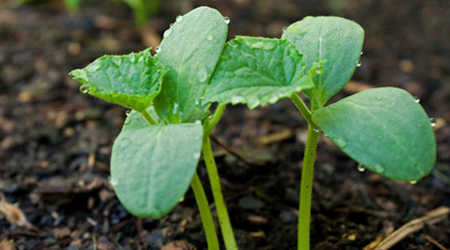 A study by Johns Hopkins University’s Center for a Livable Future warns that gardeners can be exposed to soil contaminants in a variety of ways, among them, accidental ingestion, inhalation and skin contact. The study also points out that soil ingestion is even riskier for children, who think nothing of putting their hands in their mouth and who are generally more sensitive to the effects of contaminants.
A study by Johns Hopkins University’s Center for a Livable Future warns that gardeners can be exposed to soil contaminants in a variety of ways, among them, accidental ingestion, inhalation and skin contact. The study also points out that soil ingestion is even riskier for children, who think nothing of putting their hands in their mouth and who are generally more sensitive to the effects of contaminants.
Elevated blood lead levels in children are linked with cognitive, motor, behavioral and physical problems, including an increased risk of poor performance at school and criminal behavior.
That’s why people working in urban soils should never track the soil into their dwellings on shoes, clothing and tools. As with any activities involving soil, urban agriculture must include frequent and effective hand washing.
A study from the University of Washington found that higher levels of lead in urban garden soils don’t necessary translate into lead-filled fruits and vegetables. While plants do absorb lead from the soil, it usually doesn’t go past the roots. In other words, it doesn’t move through the stems and into leaves or fruits.
But that may mean that root crops such as potatoes, turnips, carrots and beets might have a slightly higher lead content when grown in an urban garden. However, that’s not the case in crops, such as tomatoes and other above-ground produce.
“In fact, the real danger is in the soil, not in items grown in the soil,” says the report.
The study also found that using compost can actually knock out the dangerous effects of lead, even in the roots of plants. In some instances the compost will make the lead insoluble, which means it’s unlikely to be absorbed into the blood stream.
Other studies, among them “When Vacant Lots Become Urban Gardens,” which focuses on food safety concerns of urban agriculture in Ohio, suggest that there are “lower levels of soil contaminants at well-established gardens.” The reason? Tilling the soil and long-term gardening could have diluted the soil metal contaminants by mixing the contaminants with the soil.
Results from the study suggest that “long-term gardening has the potential to reduce soil contaminants and their potential threat to food quality and human health and to improve access to fresh produce in low-income urban communities.”
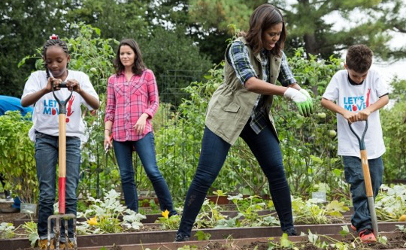
Lead levels were part of the discussion when First Lady Michelle Obama decided to plant an organic garden on the South Lawn of the White House. The reason for the initial concern was that the ground previously had be spread with biosolids, also known as sewage sludge.
Testing showed the soil needed no remediation because lead levels were low, far lower than the 200 and 400 ppm that every state agriculture extension agency in the U.S. says is safe for planting crops.
The verdict was that planting crops right in the ground was perfectly appropriate for the White House garden.
For urban gardeners and their customers
Phil Tocco, Michigan State University Extension, has a list of tips for urban gardeners.
Besides being aware of soil contaminants, he advises urban farmers to make sure their equipment — whether it be picking buckets or harvest-preparation tables — be kept sanitary with frequent washing and sanitizing.
Visitors of the human and non-human kind should be monitored at urban growing and packing sites because stray animals, neighbors, and even homeless people can pose food safety risks.
Mariel Borgman, a community food systems educator for Michigan State University Extension, offers these tips for what consumers can ask urban farmers about the safety of their food:
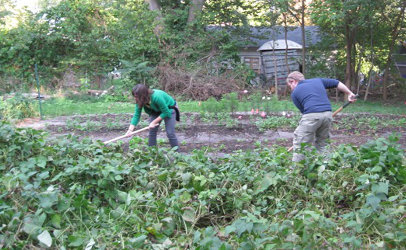
- Was the food grown directly in the soil or in raised beds? If it was grown directly in the soil, was the soil tested for lead and other heavy metals? Was it found to be safe?
- How do you protect the food from critters — rodents, birds, cats, etc. — and other unwanted visitors? Do you have a fence or some other deterrent?
- Has this produce been washed and do you use a sanitizer in the wash water? Note: If produce was not washed, it does not mean it is unsafe. This is just one particular practice that a farm may choose to use.
- How often to you sanitize your harvest equipment and bins?
- Do you have a food safety plan for your growing operation? Have your employees received training on safe food handling practices?
Borgman also said that it’s always a good idea to wash fruits and vegetables in cool running water before eating them.
The University of California Extension Service’s Jennifer Sowerwine ascribes to WASSH:
W is for water — Is it safe and clean?
A is for animal intrusions — Are they being prevented?
S S is for soil/surface contamination — Are tools and equipment and tables sanitized?
H is for hygiene — Are there restrooms and hand washing stations?
She also suggests that consumer look at the surrounding property, if they are buying urban ag commodities at farm stands. Look for things such as landfills uphill from growing areas that would receive runoff.
Sowerwine, who has been conducting food safety training in the East Bay and other areas of California, is optimistic about how things are going.
“I think there will be a broad-based awareness of food safety and the need to follow best practices,” she said. “The farmers want to make sure what they’re growing is safe and they’re really curious about how to reduce food safety risks.”
Even so, she said they are shocked about the extent of the record keeping that’s required.
“Wow, that’s a lot of paperwork,” she said they frequently tell her.
She understands because she knows the documentation is an added layer of work, which can be hard to get done on top of other work at small farms where there are few employees.
Sower wine said one thing lacking in Stabenow’s bill is a way to deal with the challenges of staying in business when land values are high. For example, a successful urban farm in the Bay Area recently had to close down because the land was slated for development.
“I would really like to see opportunities for some sort of land security and tenure — and additional support to acquire land,” she said.
Additional details on Stabenow’s bill
Agriculture Cooperatives: Expands USDA authority to support farm cooperatives in urban areas, helping urban farmers who want to form and operate an agriculture cooperative get products to market. Reduces individual financial risk and burdensome paperwork by allowing USDA loans to be managed by agriculture cooperatives.
Rooftops, Vertical Farms & Indoor Production: Makes it easier for urban farms to apply for USDA farm programs and assists producers with information on operating rooftop and vertical farms. Supports access to land and production sites in urban communities through innovative conservation grants.
Cutting-Edge Research: Invests $10 million for cutting-edge research to explore market opportunities for urban agriculture and develop new technologies for lowering energy and water needs. Includes national data collection and a new urban agriculture section in the Local and Regional Foods market report.
Loans: Expands existing USDA farm loan programs so urban farmers can cover new farm related activities that improve their business. Now urban farmers can use farm loans to finance food production, marketing, and value-added processing.
Risk Management Tools: Provides a new affordable risk management tool for urban farmers to protect against crop losses, taking into account the risks, food prices and contracts unique to urban farms.
New Urban Ag Office: Creates a new urban agriculture office at USDA to coordinate urban agriculture policies across the Department and provide urban farmers with technical assistance.
Mentorship and Education: Connects urban farmers with rural farmers to provide education and mentorship support.
Community Gardens: Invests $5 million for tools and equipment to develop community gardens that provide community-based nutrition education and donate a portion of the food grown to help feed their neighbors.
Healthy Food: Creates a new pilot program that provides incentives to urban farmers who use sustainable growing practices and commit to supplying healthy food to their neighbors, connecting urban farms with families who need greater access to healthy, local foods.
Soil Remediation: Expands resources for technical and financial support to test and clean up contaminated soils, and invests in new research on the best practices for soil remediation.
Urban Composting: Creates a pilot program to provide urban farmers access to compost while reducing food waste that would otherwise go into landfills.
(To sign up for a free subscription to Food Safety News, click here.)
